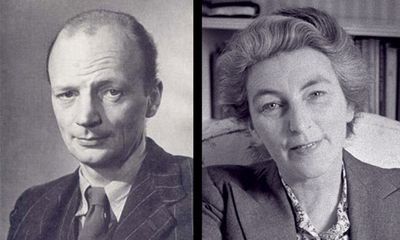Modern classics before they became modern classics
By MICHAEL CAINES
"A modern classic rarely seems able to venture out on to the bookshelves unchaperoned". So D. J. Taylor writes in the recent double issue of the TLS, in a sampling of six recently reissued novels that claim to be modern classics: "it needs a sponsor to plead its case". The sponsor being whoever supplies an adulatory preface, or an obliging line for the front or back cover, to reassure potential buyers that they are not picking up a mere modern non-classic. Louis de Bernières writing in praise of Barbara Pym's Crampton Hodnet. Candia McWilliam in praise of the "purity" and "tension" of In the Making by G. F. Green. And so on.
If you've read Taylor's piece, you'll know by now whether he agrees with such kind assessments or not. But before the books in question became "modern classics" (whatever that means), they were just novels – what did their first reviewers in the TLS make of them? Do the critics agree, across the years, and do they dare to prophesy lasting fame for any of these books? Has the critical language changed out of all recognition?
With such questions in mind, here follows a game of "modern classics" Consequences . . . .
The Blaze of Noon by Rayner Heppenstall
The sponsor says: "an under-appreciated classic of inter-war literature" (G. J. Buckell).
D. J. Taylor says: "the good intentions are sometimes crowded out by straightforward trickery".
And the TLS originally said: Nothing. We didn't review it. (This is a good start.) But when the book was reissued in the 1980s, Valentine Cunningham found it "astonishing" that the novel could once have been acclaimed as the "hottest of stuff": "its real interest now consists only in the degree to which The Blaze of Noon was an opportunistically wiggled bit of fly-paper onto which the going interests of the 1930s got themselves dutifully stuck". Others had thought Heppenstall deserved more credit than that: writing in the TLS in 1963, Julian Maclaren-Ross drew the lines of connection between autobiographical experiments such as The Blaze of Noon and Alain Robbe-Grillet.
In the Making by G. F. Green
The sponsor says: "Pure, tense, and incontrovertibly a modern classic" (Candia McWilliam).
D. J. Taylor says: "If Green has a weakness for deep-romantic-chasm adjectives like 'tenebrous', then some of the special effects . . . are startlingly good".
And the TLS originally said: "Mr. G. F. Green has written an overcharged, oversensitive account of a boy's childhood and youth" (Julian Symons). And like Taylor, he noted the novel's unfortunate fondness for words such as "peradventure".
Harriet by Elizabeth Jenkins
The sponsor says: "Forged from the unpromising prolixity of a Victorian courtroom, a powerful synthesis of truth and imagination renders it indelible" (Rachel Cooke).
D. J. Taylor says: "Harriet is rather showing its age".
And the TLS originally said: "Miss Jenkins is . . . a novelist of great ability. She has the unusual capacity for seeing clearly what is to be done and doing it completely and precisely . . .".
The River by Rumer Godden
The sponsor says: (I've misplaced my copy. Sorry. But I think we can safely say that they liked the book.)
D. J. Taylor says: The River "not only has trouble disguising its origins as a memoir of the author’s childhood (sans the violent climax) but also betrays its 'young adult' status by a faint air of didacticism".
And the TLS originally said: "The River is a short and delicately told tale of an Anglo-Indian family living in Bengal." It is "gently written and deftly constructed". It is a "pleasant little book". That was in 1946. Twenty years later, Paul Scott could write of the "magic-in-recollection" of Godden's novel in combination with Jean Renoir's film.
Crampton Hodnet by Barbara Pym
The sponsor says: "An entertainment that is funny, poignant, observant and truthful" (Louis de Bernières).
D. J. Taylor says: "the effect is rather like a Firbank novel with all the blood drained away".
And the TLS originally said: "One only wishes that the editors had relieved it of its hideous provisional title when they rescued the manuscript from undeserved obscurity in the Bodleian Library." There were other problems, Miranda Seymour thought, with plot, characterization, jokes and excessive recourse to "tea-and-scandal sessions". But these were "inconsequential" faults in a novel "so richly endowed with Pym's clear intelligence".
Mrs Bridge by Evan S. Connell
The sponsor says: the eponymous heroine of Mrs Bridge is "a reflection of you and me, an exemplar of our shared humanity and all the terror and opportunity it so briefly provides" (Joshua Ferris).
D. J. Taylor says: "On more than one level, Mrs Bridge’s great – in some ways its only – theme is survival. For all the rueful comedy that surrounds her life, its heroine’s chief task is to endure the battering of an indifferent and naturalistic world. In doing so she advertises some of the qualities necessary for a novel to extend its usual chronological span, transcend some of its built-in limitations, defy obsolescence and go on living. Identifying these bench-marks is not always easy: usually the reader merely notes a taxonomic black hole, an uncategorizable resonance that the other sheep whipped into the modern-classical pen mysteriously don’t possess. But whatever they are, Evan S. Connell has them in superabundance".
And the TLS originally said: Do we have a "small masterpiece on our hands"? Mrs Bridge was a book David F. Williams could praise as "often funny, sometimes tragic, always tenderly ironic".
As in Taylor's round-up, then, the points go to Evan S. Connell.
Note, however, that in his review of an earlier reissue of Mrs Bridge in 1983, David Montrose could assert that the sequel, unsurprisingly titled Mr Bridge, was the "better novel". Has the publisher missed a trick?
Of course not: Penguin plan to reissue Mr Bridge in the spring.
Peter Stothard's Blog
- Peter Stothard's profile
- 30 followers




